
The Choctaw are a Native American people originally based in the Southeastern Woodlands, in what is now Alabama and Mississippi. Their Choctaw language is a Western Muskogean language. Today, Choctaw people are enrolled in three federally recognized tribes: the Choctaw Nation of Oklahoma, Mississippi Band of Choctaw Indians, and Jena Band of Choctaw Indians in Louisiana.

Hockey is a term used to denote a family of various types of both summer and winter team sports which originated on either an outdoor field, sheet of ice, or dry floor such as in a gymnasium. While these sports vary in specific rules, numbers of players, apparel, and playing surface, they share broad characteristics of two opposing teams using a stick to propel a ball or disk into a goal.

Lacrosse is a contact team sport played with a lacrosse stick and a lacrosse ball. It is the oldest organized sport in North America, with its origins with the indigenous people of North America as early as the 12th century. The game was extensively modified by European colonists, reducing the violence, to create its current collegiate and professional form.

Box lacrosse, also known as boxla, box, or indoor lacrosse, is an indoor version of lacrosse played mostly in North America. The game originated in the 1930s in Canada, where it is more popular than field lacrosse. Lacrosse is Canada's official national summer sport. Box lacrosse is played between two teams of five players and one goalie each, and is traditionally played on an ice hockey rink once the ice has been removed or covered. The playing area is called a box, in contrast to the open playing field of field lacrosse. The object of the game is to use a lacrosse stick to catch, carry, and pass the ball in an effort to score by shooting a solid rubber lacrosse ball into the opponent's goal. The highest level of box lacrosse is the National Lacrosse League.

A face-off is the method used to begin and restart play after goals in some sports using sticks, primarily ice hockey, bandy, floorball, broomball, rinkball, and lacrosse.
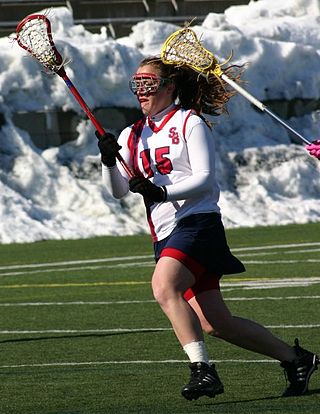
Women's lacrosse, sometimes shortened to lax, is a field sport played at the international level with two opposing teams of ten players each. Originally played by indigenous peoples of the Americas, the modern women's game was introduced in 1890 at the St Leonard's School in St Andrews, Scotland. The rules of women's lacrosse differ significantly from men's field lacrosse. The two are often considered to be different sports with a common root.
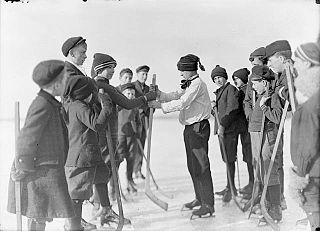
Shinny is an informal type of hockey played on ice. It is also used as another term for street hockey. There are no formal rules or specific positions, and often, there are no goaltenders. The goal areas at each end may be marked by nets, or simply by objects, such as stones or blocks of snow. Body checking and lifting or "roofing/reefing/raising the puck" are often forbidden because the players are not wearing protective equipment. Shinny is a game that all levels of hockey enthusiasts can play because it requires no rink, requires no skills except ability to hold a stick and at the very least to try to touch the puck or ball when it goes by. Shinny may be completely non-competitive and recreational.

Field lacrosse is a full contact outdoor sport played with two opposing teams of ten players each. The sport originated among Native Americans, and the modern rules of field lacrosse were initially codified by Canadian William George Beers in 1867. Field lacrosse is one of three major versions of lacrosse played internationally. The rules of men's lacrosse differ significantly from women's field lacrosse. The two are often considered to be different sports with a common root. An outdoor six-a-side version, lacrosse sixes, was established in 2021 and features six players per team, reduced field size, and shorter duration to be conducive for daily tournament play. Another version, indoor box lacrosse, is also played under different rules.
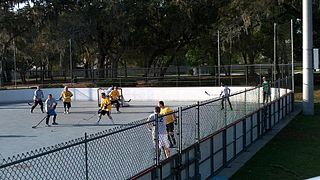
Street hockey is a collection of team sport variants played outdoors either on foot or with wheeled skates, using a either a ball or puck designed for play on flat, dry surfaces. The object of every game is to score more goals than the opposing team by shooting the ball or puck into the opposing team's net. All games are derivatives of either the sport of ice hockey, floor hockey, bandy, and/or field hockey.
Cross and circle is a board game design used for race games played throughout the world.

Lacrosse has its origins in a tribal game played by eastern Woodlands Native Americans and by some Plains Indians tribes in what is now the United States of America and Canada. The game was extensively modified by European settlers to create its current collegiate and professional form. There were hundreds of native men playing a ball game with sticks. The game began with the ball being tossed into the air and the two sides rushing to catch it. Because of the large number of players involved, these games generally tended to involve a huge mob of players swarming the ball and slowly moving across the field. Passing the ball was thought of as a trick, and it was seen as cowardly to dodge an opponent. Years later lacrosse is still a popular sport played all over the world. The indigenous people would wear their normal clothes and use a wooden stick and they would play the game with 100-1000 players on each team and they played on 1-2 kilometer fields.

Handgame, also known as stickgame, is a Native American guessing game, in which marked "bones" are concealed in the hands of one team while another team guesses their location.

Chunkey is a game of Native American origin. It was played by rolling disc-shaped stones across the ground and throwing spears at them in an attempt to land the spear as close to the stopped stone as possible. It originated around 600 CE in the Cahokia region of what is now the United States. Chunkey was played in huge arenas as large as 47 acres that housed great audiences designed to bring people of the region together. It continued to be played after the fall of the Mississippian culture around 1500 CE. Variations were played throughout North America. Early ethnographer James Adair translated the name to mean "running hard labor". Gambling was frequently connected with the game, with some players wagering everything they owned on the outcome of the game. Losers were even known to commit suicide.
A lacrosse stick or crosse is used to play the sport of lacrosse. Players use the lacrosse stick to handle the ball and to strike or "check" opposing players' sticks, causing them to drop the ball. The head of a lacrosse stick is roughly triangular in shape and is strung with loose netting that allows the ball to be caught, carried, passed, or shot.
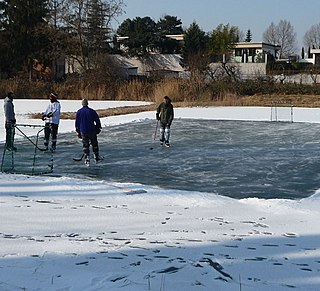
Pond hockey is a form of ice hockey similar in its object and appearance to traditional ice hockey, but simplified and designed to be played on part of a natural frozen body of water. The rink is 50 to 80 percent the size of a standard NHL-specification rink, and has no boards or glass surrounding it; usually only a barrier of snow keeps the puck in play. In addition, because there are no protective barriers behind the goal to contain high errant shots, the top of the goal is lower, in fact only slightly taller than the width of a puck, and the game does not have a formal goalie. Because of these differences, pond hockey places more emphasis on skating and puckhandling ability and less on shooting and checking. Non-competitive pond hockey is played with improvised goals, rinks of a variety of sizes, and no boards or snow barriers. There can only be 4 players playing per team at a time but have many subs to sub in.
Shinney is a game from North America.
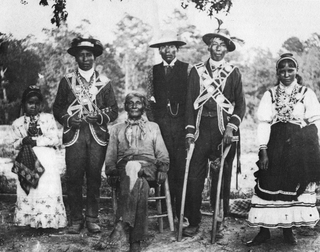
The culture of the Choctaw has greatly evolved over the centuries combining mostly European-American influences; however, interaction with Spain, France, and England greatly shaped it as well. The Choctaws, or Chahtas, are a Native American people originally from the Southeastern United States. They were known for their rapid incorporation of modernity, developing a written language, transitioning to yeoman farming methods, and having European-American and African-Americans lifestyles enforced in their society. The Choctaw culture has it roots in the Mississippian culture era of the mound builders.

Zohn Ahl is a roll-and-move board game played by the Kiowa Indians of North America. It is often cited as a typical representative of many similar Native American games. It is often equated with Tsoñä, also played by the Kiowa.

The sport of lacrosse has been played in the United States by Native Americans long before European exploration. The sport is most popular in the northeast and mid-Atlantic areas of the country. However, the game has recently developed into a popular team sport for both men and women in all regions of the United States.

Early Native American recreational activities consisted of diverse sporting events, card games, and other innovative forms of entertainment. Most of these games and sporting events were recorded by observations from the early 1700s. Common athletic contests held by early American tribes included games of stickball, chunkey, archery, darts, foot races, and canoeing. Card and dice games were commonly used as forms of entertainment among tribes such as the Iroquois and Lakota. Several contests and games invented by American indigenous groups contributed to modern-day sports and casino play. Several indigenous games were tribe-specific; one of the most common games played specifically by the Iroquoian was the Bowl Game, played using colored balls and sticks.






















